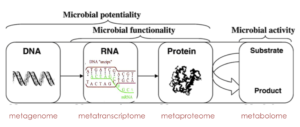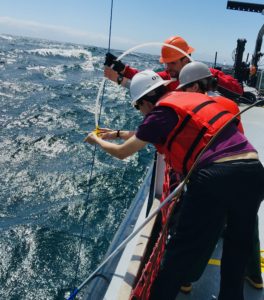Wednesday, May 29, 2019 – Running Transects in Search of Active Upwelling
PUPCYCLE Log – Day 06: On the Cutting Edge of Metabolomics
There are several groups of scientists on the R/V Oceanus and each group has specific research goals for which they are collecting data during the 2-week cruise. Although each group has independent objectives, their research overlaps throughout. One of the key areas of overlap falls under the new scientific realm of Bioinformatics. Bioinformatics breaks genomics down into deeper divisions and is changing our understanding of living organisms. Most of us became familiar with genomics after the turn of the century when the human genome was decoded. Scientists have since delved further into the DNA molecule with transcriptomics, determining when genes are turned “on” or turned “off”. This is often referred to as gene expression.

Travis’ focus during PUPCYCLE 2019 is to investigate the biogeochemistry of trace metals, like iron (Fe), found along the California Upwelling Zone (CUZ). In particular, Travis hopes to draw connections between the molecules connected to Fe and the gene expression of diatoms as they follow the UCBC (Upwelling Conveyor Belt Cycle) along broad and narrow shelf regions. By tracking an active upwelling event, Travis is observing the molecular responses of diatom communities to determine if certain species of diatoms have adaptations allowing them to out compete other species during upwelling. As noted in the previous entry, narrow shelf regions of the coastline have limited iron availability because run-off from land has less area for accumulation before being transported into the deep ocean. Fe-limited environments reduce the ability of diatoms to take up nitrate and other important nutrients. When the diatoms have limited iron availability, they become stressed. Travis wants to know how the diatoms handle this stress and adapt to the Fe-limited environment. Metabolomics protocols will allow him to assess the biogeochemical responses of diatoms to Fe-limited marine environments. In addition, Travis wants to know if other molecules in their environment drive the responses of the diatoms or if the diatoms are willingly expressing certain genes to create the molecules necessary for survival.

Travis Mellett was born in the San Francisco Bay area. He completed a double major as an undergraduate, in Earth Sciences and Environmental Studies at the University of California – Santa Cruz. He is completing his doctoral studies in Chemical Oceanography at the University of South Florida and begins a post-doc at Humboldt State University after PUPCYCLE 2019.
